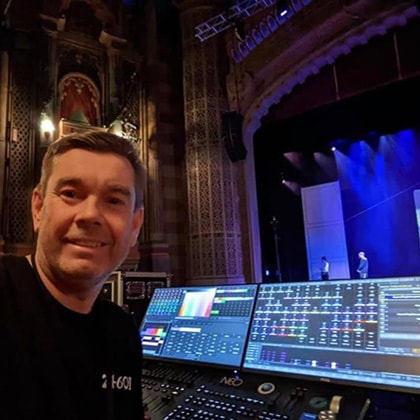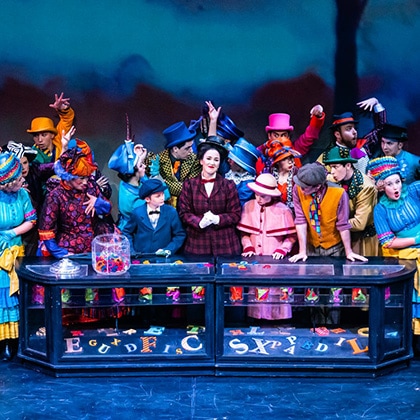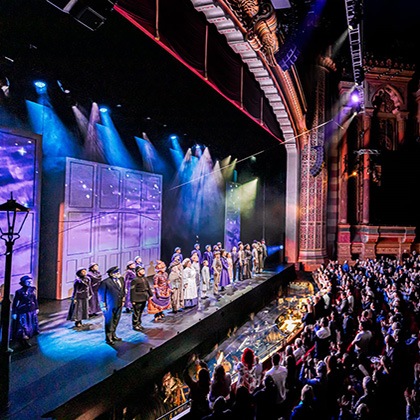Auckland, New Zealand – On October 15, seven months after COVID-19 pandemic restrictions forced theaters and entertainment venues across the world to go dark, Mary Poppins – The Broadway Musical, took to the stage at Auckland’s Civic Theatre for a two-week run.
Produced by The Amici Trust, directed by Russell Dixon, and played to a capacity audience, the show’s opening performance was a beacon of hope to theater crews, performers, and audiences across the world.
Of course, the production had its own share of uncertainty and delay: New Zealand’s COVID-19 response system instigated full lockdown in March, just two weeks before the planned opening night. The cast continued to rehearse - initially via Zoom, and later singing in masks – as Auckland’s COVID-19 fortunes rose and fell. A rescheduled September opening was hit by a second wave, but finally, in October, gatherings and performances could take place once again. The show was on.
For lighting designer Martin Searancke, the go-ahead was a key moment. “I was unaware how much the original lockdown had affected me personally, until I received the call. There was such a lift in my mood that it really made me realize the impact this was having on our industry everywhere.”
To light the landmark production, Martin specified 12 Vari-Lite VL2600 PROFILES from the production’s lighting supplier Xytech Lighting Systems as the workhorse fixture of his rig. Eight were flown above stage, and four positioned on the front truss – all handling equal shares of texturing and profile work. Alongside these, Martin also specified fixtures from earlier Vari-Lite product generations – including six VL3000 SPOTS and 10 SL BEAM 300FX LED fixtures.
“It's a show with a lot of varied scenes,” he explains, “from large, expansive parlor scenes that required a full stage wash, to fantasy scenes like Supercalifragilisticexpialidocious, and grungy rooftop/street scenes. I think the rooftop was one of my favorites, because of the creative angles and indirect lighting that I could use. The fantasy scenes were a chance to play with lots of color; I tried to light them like a pastel painting.”
He continues, “The biggest challenge was the large and complex set, which was projected onto. I had to constantly be aware of not washing out the projection with lighting. This was the main reason I chose the VL2600 PROFILES as my primary fixture - their framing system allowed me to accurately trim light from set elements.”
Another key factor in his choice was the inherent versatility of the fixtures. “Because of the complex nature of the set and the varied scenes, the VL2600s significantly reduced the number of lights required, and allowed far more accurate lighting than I could have achieved with a more conventional rig, or with other movers that I have used in the past,” he says.
“The VL2600 PROFILE is so versatile that there was no moment during plotting that I thought, ‘I wish it could do this.' It’s a very complete fixture, with everything I want from a theater luminaire.”
Martin also praises the VL2600’s color system. “The color engine is excellent,” he says. “I was slow to use LED to front light people in my designs, but for this show I was more than happy with the colors I could achieve. And in terms of brightness, they hold their own against the VL3000s, and complement them very well.”
Expanding further on the attributes of the VL2600’s powerful LED engine, Martin says, “The low power consumption was not a significant consideration during the design. However, I was astounded at how little power distribution this show required. When I was calculating the power requirements, I kept thinking I must have missed something. This experience has made me realize how much simpler LED can make things.”
He adds, “They certainly met my expectations, and more. I would describe them as one of the easiest fixtures I have ever worked with. I’d specify them in future designs without hesitation.”
For his control system, Martin chose a NEO – a console he knows intimately, having worked on the development of its software. However, he also took along a brand-new member of the NEO range - the new NEO COMPACT 10. He explains. “This was primarily so that during rehearsals the operator could run the show while freeing up the main console to make tweaks and changes. Because the COMPACT 10 is the same software, it’s able to connect as a remote console and control the same show.
“But the real power of this was that, once the show was plotted, I could take the COMPACT 10 up to the dress circle and clean up some of the textures and positions from this different vantage point, without needing to take the full console. I did several sessions tweaking the show from this location in the last few days before opening.”
Martin also took the opportunity to try out some of the new features included in the latest software version. “The new software includes the ability to spread attribute timing using a matrix and this was used effectively to get a color change to correlate with a video projection wipe effect happening on the set,” he explains.
This memorable opening night was a happy occasion, not just for the full-house audience in the beautiful Civic Theatre, but for the cast and crew whose work lives had been on indefinite hold for so long. On social media, the response to Martin’s post about the show from production industry personnel worldwide was warm and heartfelt. “I was overwhelmed by the response,” says Martin. “It reinforced my view of how uniquely passionate people who work in the entertainment industry are.”
At the curtain call, Shaan Kloet, who plays Mary Poppins in the production, delivered a message to all those around the world whose theaters are dark, saying, “The Mary Poppins cast and crew are thinking of you guys and we hope that you raise your curtains really soon. We are sending all of our love from the Auckland Civic Theatre here in New Zealand.”








